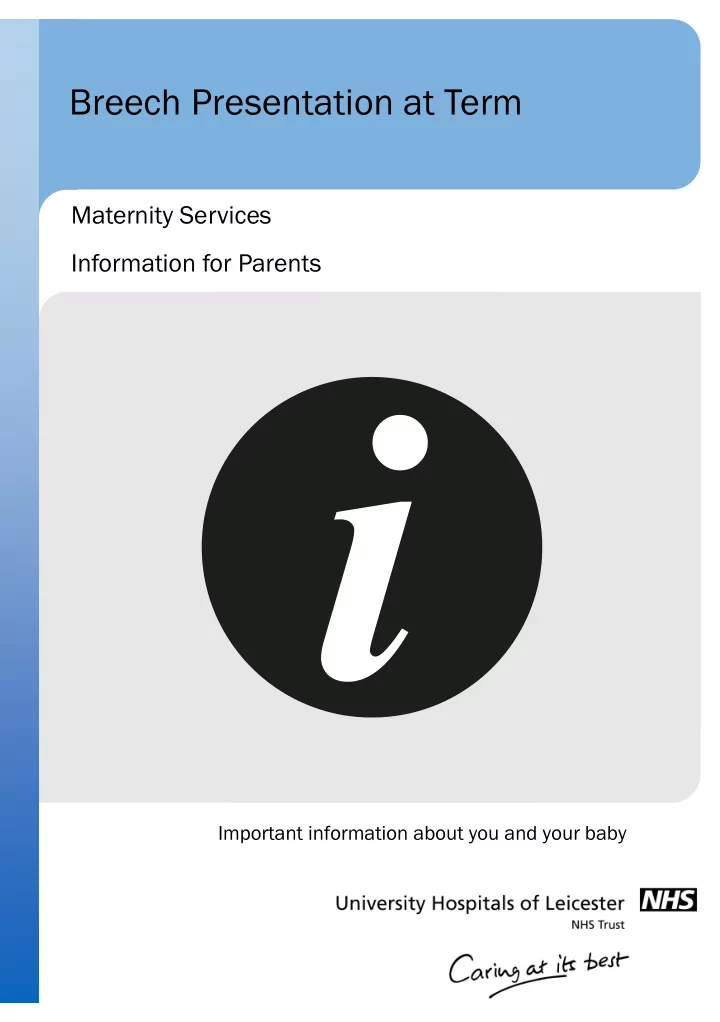

Breech Presentation at Term Maternity Services Information for Parents i Important information about you and your baby
Breech Babies & ECV Most babies are positioned head - down for the last two months of pregnancy (from about 34 weeks onwards). However, breech babies present buttocks - first. Although breech presentations are very common in early pregnancy, only about 3% of babies remain breech after 37 weeks. There are three options for delivery if your baby remains in a breech presentation after 37 weeks: 1. Vaginal breech delivery 2. Elective caesarean section 3. External cephalic version (ECV) This leaflet has been written to provide you with information about these options. 2
1. Vaginal Breech Delivery Provided that your pregnancy has been uncomplicated, this is an option. However, recent evidence suggests that vaginal breech delivery does carry an increased risk. In about 2 in 1000 vaginal breech deliveries, the baby suffers some complications related to childbirth. Some of these complications will be mild and resolve completely but others will have long - term effects. These complications are neither predictable nor completely preventable. This may lead health professionals and women to seek alternatives for breech babies at term. 2. Elective Caesarean Section This avoids a vaginal delivery altogether. It lowers the risk of complications for the new - born to about 0.5 in 1000. However, it is major surgery for the mother, involving a longer hospital stay, greater blood loss and potential complications in subsequent pregnancies. Elective caesarean sections are carried out after 39 weeks, to minimise the risk of breathing difficulties for the new - born. If you choose to have your baby by elective caesarean section you will have a scan prior to your operation. This will be to confirm that your baby remains in a breech position. If your baby has turned around and is presenting head first then your operation will be cancelled unless there are other clinical reasons why a caesarean section is required. 3
3. External Cephalic Version (ECV) ECV involves turning the baby, using gentle but firm pressure applied to your abdomen, in a manner similar to a routine antenatal check - up. ECVs are performed in hospital with you lying on a sofa or bed. Neither anaesthesia nor analgesia is routinely given. Obstetricians, using ultrasound for guidance, carry out the procedure. When is ECV carried out? Ideally at 37 - 38 weeks. This is because the amount of fluid around the baby gradually decreases after this, reducing the chances of success. It also becomes increasingly common for the breech to descend into the pelvis or “engage”, another factor associated with difficulty carrying out ECVs. Does ECV carry any risks? ECVs are generally safe, about 1:200 babies undergoing the procedure would require delivery by caesarean section due to bleeding from the placenta or changes in your baby’s heart rate. For this reason, we have an emergency pathway for this to take place immediately if required. 4
How successful is ECV? Generally speaking, about 50 - 60% of breech babies can be successfully turned. The success rate is slightly higher in women who have had babies before and slightly less with first babies. Most obstetricians will use a drug, such as terbutaline, to relax the muscles of the womb. This drug is safe in pregnancy but has the side effect of increasing your heart rate. Some women notice this as palpitations. These side effects rapidly disappear as the drug only works for a few minutes. 5
Information If the procedure is successful, you will be allowed to go home to await spontaneous labour. The chance of the baby changing back to a breech is approximately 3%. If the baby does change back to a breech presentation, we can discuss your options, which include repeating the ECV, vaginal breech delivery or caesarean section. If you are Rh D negative you will be given a dose of anti - D (500units) and have blood test prior to discharge to check if further doses of anti - D are required. IMPORTANT INFORMATION After an attempted ECV (regardless of whether or not it was successful), you should watch for and promptly report any of the following symptoms: Abdominal pain Vaginal bleeding Any sudden reduction in your baby’s movements You should telephone the maternity assessment unit immediately. External cephalic version (ECV) at term is safe and has been shown to reduce the need for delivery by caesarean section. 6
ECV Booking Checklist Breech confirmation on ultrasound Gestation >37 weeks No other reason not to deliver vaginally Booked with ECV/ Breech clinic Date and time to attend Clinic given Date: ……………………………………………… at: …………………………………………..hours Further information is available from: Antenatal Services Midwives, LRI 0116 258 6106 Antenatal Services Midwives, LGH 0116 258 4829 Delivery Suite, LRI 0116 258 6451 / 6452 Delivery Suite, LGH 0116 258 4807 / 4808 7
Today’s research is tomorrow’s care We all benefit from research. Leicester’s Hospitals is a research active Trust so you may find that research is happening when you visit the hospital or your clinic. If you are interested in finding out how you can become involved in a clinical trial or to find out more about taking part in research, please speak to your clinician or GP. If you w If y ou would like this uld like this i inform nformat ation ion in another lang in another languag uage or e or form format at, , pleas lease c e contac ontact t t the he servic ervice equalit e equality m manager o anager on n 0116 2 250 2 2959 Jan 2008 Reviewed: August 2017 Next Review: August 2019 (Matthews) WPS035 - 0817
Recommend
More recommend